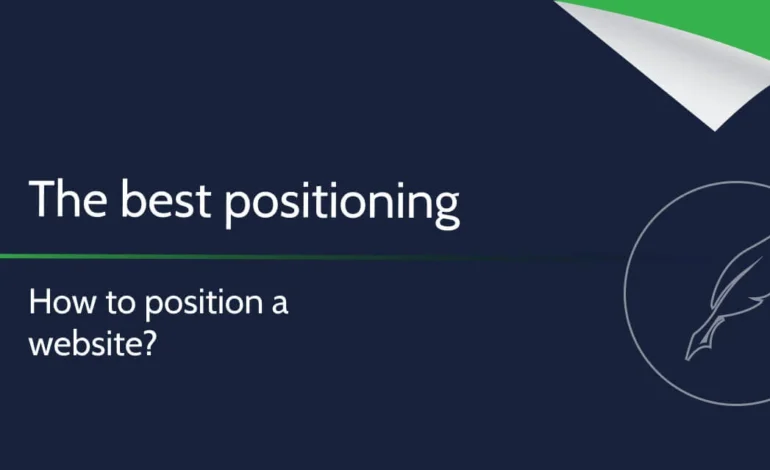Web positioning: 20 steps to be the first

Web positioning is the pillar on which many online marketing strategies are based. If your website or blog manages to appear in the top positions, you will be attracting a lot of visits and, with them, potential customers to attract to your conversion funnel.
In the race to improve your web rankings and appear first on Google, you will have to face stiff competition. To fight this battle successfully, I’m going to share with you 20 steps, tips, and recommendations to improve your SEO once and for all.
Take care of the basics of web positioning
To build a good web positioning, you have to start with the foundations. Controlling these four basic points will help you go very far.
1) Work on on-page SEO
We call “on-page SEO” the management of the internal aspects of your website that contribute to its positioning.
On-page SEO starts with a good choice of keywords for which we want to position our website. With this in mind, we will pay attention to aspects such as:
- The domain of the website. Making a good choice will save you a lot of headaches later.
- The structure. Your website should have a neat and understandable “skeleton” for both search engines and humans.
- The content. Search engine optimization and content marketing are first cousins, as Google spiders love websites with up-to-date and quality content.
- Labeling. Tags help search engines correctly interpret a site’s content.
- The site map. It must be present, well signposted and legible.
2) Don’t forget about off-page SEO
“Off-page SEO” is the elements external to your website that contribute to its positioning. Its main element is the creation of links from other websites to yours.
When it comes to link-building campaigns, we can resort to different techniques, such as guest posting or directories, but always being careful to avoid spam and not incur penalties. It is better to go little by little and not risk losing everything we have achieved at once.
3) Think about the user
One of the big problems with web positioning is that we can become obsessed with the factors that improve rankings and forget that our content is intended for humans and not search engines.
So when implementing SEO techniques, never sacrifice the usability and readability of your site. If people love your website, the rest will follow.
4) Combine and reinforce SEO and SEM strategies
While SEO is a medium-long-term bet, SEM allows you to obtain much faster results. They both use keywords to rank your website, so it’s important to work in a coordinated manner: for example, it may not make sense to pay to rank for a keyword for which your website appears organically, or you may want to use SEM for more sales-related searches and SEO for content searches. Think about your conversion funnel and where the different elements fit in.
Don’t miss these web positioning tools.
Web positioning can be very complex, as a multitude of factors have to be assessed, and sometimes it can be very difficult to get a global idea. Luckily, many tools can give us a hand. Check out these suggestions:
5) Google AdWords Keyword Planner
The basics of the basics. This Google AdWords tool allows you to obtain information about the searches made by users in your search engine, such as the number of searches, geographical segmentation, and related suggestions. If you have an active account on the tool, the data is more detailed.
6) MOZ Tools
This company offers a lot of solutions for researching keywords, auditing your site, designing your link building, and optimizing your page in general. Moz Keyword Explorer, Open Site Explorer, and MozRank stand out.
7) SEMrush
It allows you to get keyword ideas and see which of your competitors’ sites are getting the most traffic.
8) Ubersuggest
Another very interesting option for researching keywords, as it suggests ideas based on the term you enter. This way, you can broaden your horizons and see if there’s anything you’re missing.
9) Merge Words
If you want to refine your keywords even more, this tool works as a “mixer” that allows you to combine terms or segment several words within the same one.
10) Google Trends
Finally, another Google basic that allows you to see search trends over time and in different locations.
Latest trends in web positioning
Web positioning is a discipline that does not stop advancing, and search engines continuously refine their algorithms to adapt to changes in the environment and offer increasingly better results. That’s why, if you want to be the first on Google, you’ll need to incorporate these 10 new features into your strategy:
11) Voice searches
Did you know that… 1 in 5 Google searches is already done through voice? Virtual assistants have changed the way we search for information, as we generally use longer, more colloquial, and more specific sentences. Therefore, there is no choice but to give your website’s keywords a spin.
12) Natural searches
About the above, Google is giving more prominence to keywords in the form of questions, so it makes sense to articulate your content in the form of an answer.
13) Link Purchase Penalties
Google is keeping an eye on link-building techniques more than ever to avoid fraud aimed at getting a lot of inbound links in a short time. So beware of paying in exchange for links in the media or abusing interested guest posting.
14) The mobile version is decisive
So much so that from now on, pages will be indexed based on their mobile version first and will only take into account the browser version later. There’s no excuse not to have your mobile page ready!
15) Content: quality is worth more than quantity
It is no longer enough to accumulate words to make long articles: according to the latest search criteria, what counts most is “dense content”, that is, articles that are not too long but in which related ideas and data are condensed.
16) More extensive descriptions
So-called “snippets” are the descriptions of your website that are displayed on the Google results page and are essential for the user to click. Now you have room for more characters, so take advantage of it!
17) More safety requirements
The HTTP5 security protocol, until now only mandatory in e-commerce, will be applied to any website that requests user data through a form. The risk of not complying with this requirement is that our website will be considered “insecure” and severely penalized.
18) Charging speed, more important than ever
While it has always been a determining factor of on-page SEO, its importance could increase even more in the coming months.
19) Network traffic counts
While SEO and social media have traditionally been considered as separate channels, we are seeing a greater influence of social traffic on the positioning and online reputation of brands.
20) YouTube as a ranking factor
YouTube is the second most important search engine on the web, so ranking here is also essential. Don’t overlook it!
After these 20 keys to web positioning to be number 1 in Google searches or any other search engine, you will surely have several ideas to optimize and improve your SEO techniques. You’ll tell us!










